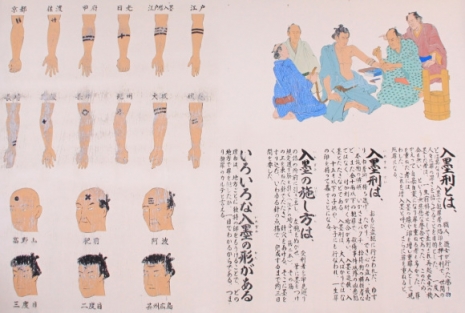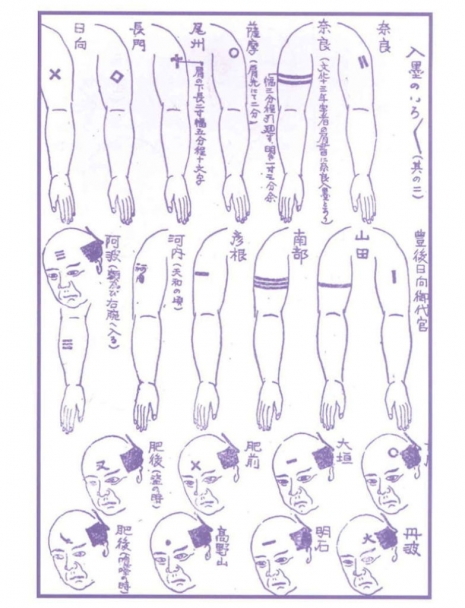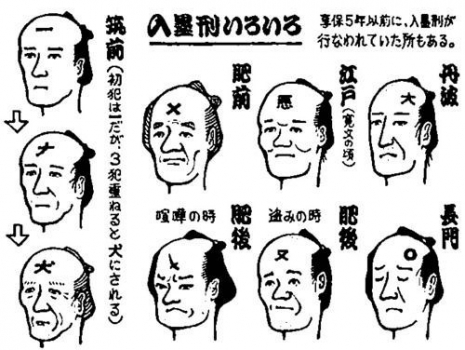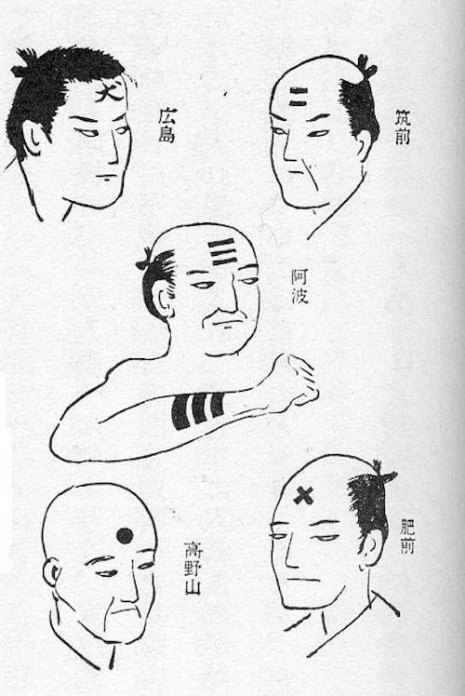
An example of the various face tattoos given to criminals in Japan during the Edo Period.
The art of tattooing has a very long history in Japan and artifacts that date back as far as 5,000 BC such as figurines made of clay with etchings on their faces or that have been painted with designs in the spirit of body art have been discovered.
Tattoos have many different symbolic meanings in Japanese culture and can denote where an individual ranked in society or serve as a permanent means of defense against evil forces or perhaps members of the animal kingdom. With the arrival of the seventh-century, the idea of tattooing one’s body in order to make it more beautiful began to lose its appeal due to the strong influence of Chinese customs in Japan—specifically when it came to identifying and tracking criminal activity. Around 720AD during the Nara Period, it appears that tattooing as a form of punishment began to infiltrate Japanese culture. Once the dawn of the Edo Period began the art form was more widely used as a punishment for criminals as at the time there was really no such thing as a prison to send lawbreakers off to. There was a sharp rise in crime in Japan prior to the development of epicenters such as Tokyo or Osaka.
Though tattoos were still used as a way to distinguish various classes of citizens, they were also used to designate ne’er do wells such as murderers who were recipients of head tattoos so everyone would see what they had done. Designs differed across the country so in Hiroshima, you might see the symbol for “dog” on someone’s face who has broken the law. Hiroshima also utilized a “three-strike” rule in which the Chinese symbol for “large ” (大) was used to log the number of crimes committed by an individual. The completion of the symbol was the equivalent of a death sentence for the person adorned with it. In other regions, you might see a series of lines on a criminal’s arm (one for each new crime) or perhaps an arrangement of dots on a forehead. In what is now known as Nagasaki an image of a cross which for the purpose of identification translated to “bad” would also be affixed forever on the forehead.
While this all sounds pretty terrible it’s important to note that tattooing criminals replaced the far more barbaric practices of limb removal, cutting off an ear or perhaps a nose depending on the severity of the crime that was committed. The decapitated heads of criminals were also used as a deterrent to help dissuade bad guys from doing bad things. All of which make the idea of tattooing criminals seem pretty damn tame comparatively.
Images of the outlaw tattoos follow.


A depction of a criminal receiving a tattoo for his crime.


The three faces in to the left demonstrate the “three strike” tattoo.


A row of decapitated heads meant to serve as a deterant to other criminals during the Edo Period.
Previously on Dangerous Minds:
Yakuza: Beautiful hand-painted vintage portraits of tattooed Japanese gangsters
‘Jigoku’: The brilliantly grim Japanese horror film about Hell
Bizarre and beautiful Japanese prints depicting the giant catfish who causes earthquakes
Curious depictions of syphilis, measles, gonorrhea & other diseases from 19th-century Japan